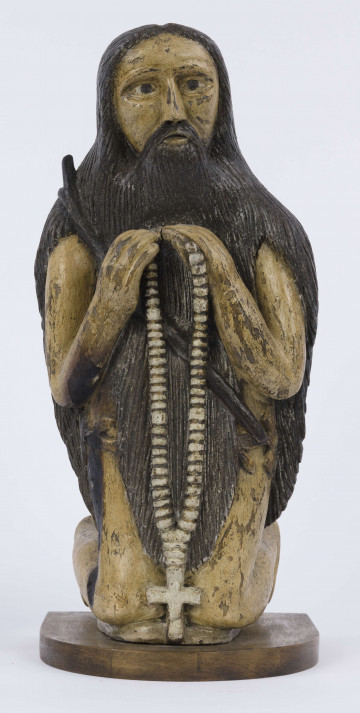
Saint Anne
1880 — 1900
National Museum in Lublin
Part of the collection: Folk Art of the Lublin Region (17th–1st half of the 20th c.)
In folk art, Marian themes are as frequent as Christological ones. Mary was usually depicted with the newborn child and as a mother suffering after the death of her son. The images were often modelled on miraculous images from pilgrimage sites. Those illustrating other periods of her life are more interesting. For example, the Immaculate Conception as a representation of Mary standing on a globe, crushing the head of a snake wrapped around the Earth and holding an apple of paradise in its mouth, or the Coronation showing Mary concentrated on prayer in the company of the Holy Trinity. Among the folk sculptures there are many representations of the Virgin Mary as an Orant in a kneeling or standing position, with her hands folded in prayer. In some, a rosary also appears in the hands of the figure.
Iconographically, the cult of the Virgin Mary is not associated with a particular image or shrine, but with prayer and devotion to the rosary. Thus, it did not influence the formation of a new type of representation. The artistic imagination adapted existing models (Orant, Madonna with Child), equipping them with a new attribute - the rosary. But where did it come from, since during her earthly life she could not have known the rosary, whose symbolism is based on Marian apparitions later confirmed by the Catholic Church, and thus recited any of its prayers, popularized only since the Crusades, originally known as the Psalter of the Blessed Virgin Mary?
The feast of Our Lady of the Rosary as Our Lady of Victory Day was instituted by Pope Pius V in 1572 to commemorate the battle fought the year before at Lepanto against the Turkish fleet of the Ottoman Empire. The victory was attributed to the rosary prayed during a procession through the streets of Rome. During the pontificate of subsequent popes, the name of the feast was modified (Feast of the Rosary, Feast of Our Lady of the Rosary), but it was always celebrated in October, and the rosary became the universal prayer. Today, the prayer is associated with the cult and revelations of Our Lady of Lourdes and Our Lady of Fatima.
Author / creator
Dimensions
cały obiekt: height: 41 cm
Object type
sculpture
Technique
polychromy
Material
wood
Creation time / dating
Creation / finding place
Owner
The National Museum in Lublin
Identification number
Location / status

1880 — 1900
National Museum in Lublin

1894 — 1930
National Museum in Lublin

1801 — 1900
National Museum in Lublin
DISCOVER this TOPIC
Museum of King Jan III's Palace at Wilanów
DISCOVER this PATH
Educational path